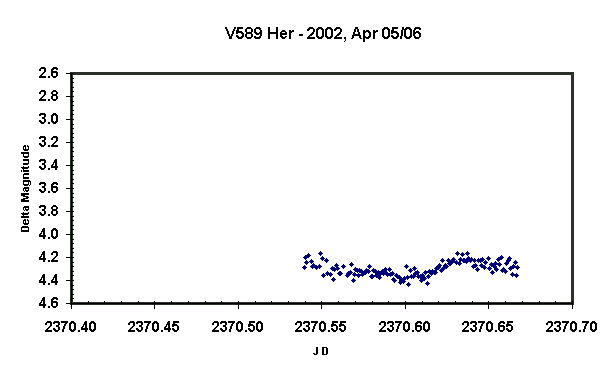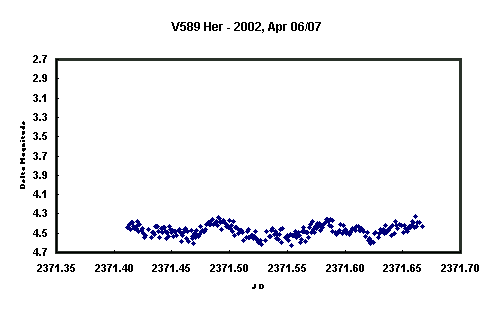V589 Her -
A new SU UMa type dwarf nova in the period gap
V589 Her (= S 10296), located at RA = 16h22m07.19s,
Dec = +19°22'36,3" (J2000.0) is classified as a UG-type
cataclysmic variable with a
magnitude range of 14.1p - <17.5p. The object is having infrequent
outbursts, and is subject to few
detailed studies only. As an illustration : only two outbursts of the
object were reported in 1999 and 2000 to VSNET. The spectrum of the object
was determined by Szkody & Howell (Szkody, P. and Howell, S.B. 1992,
ApJS, 78, 537).
Earlier attempts to detect superhumps in this system
were unsuccessful (e.g., see my July 2001
observations).
On 2002, April 4.344 UT, Mike Simonsen (USA) announced his visual
detection of an outburst of V589 Her. The Kyoto observing team reported
the observation of 0.1 - 0.15 mag modulations (vsnet-campaign-dn 2257), an
the possible existence of an eclipse-like dip, based on a 1.4 hours run
obtained on Apr 5, 2002.
I started a 3.1 h (unfiltered) CCD photometry
session of V589 Her, on April 05/06, 2002 at CBA Belgium
Observatory. As usual, a 0.35-m f/6.3 telescope and ST-7 CCD were the main
equipment. Weather conditions during the observing session were moderate :
clear skies but heavy winds. The light curve (fig below) showed a periodic
modulation with a 0.12 mag
amplitude, as was also announced by the Kyoto team, but did not confirm
the eclipse-like dip reported by the Kyoto staff. This first observing session was too short to firmly conclude on the
nature of the modulation (vsnet-campaign-dn 2265).

On April 06/07, 2002, sky conditions were perfect over Belgium, and this
allowed me to follow V598 Her during 6.1 hours (unfiltered CCD
photometry). This time, the light curve (below) clearly showed the
presence of superhump-like modulations with an average amplitude of 0.1 mag. The object was reported at mag 15.3C,
and was already fading from its superoutburst (about 0.2 mag fainter than on Apr
05/06).

I had another clear observing night on April 07/08, 2002, during which I
could successfully follow V589 Her. The object again had faded compared to
the previous night (average unfiltered mag : 15.6C), and I had to use
substantially longer exposure times to generate sufficient 'counts'. The resulting light curve
(below) still shows the existense
of 3 superhumps, although less qualified than on the previous two nights.

Meanwhile, I also received two good quality data sets of
V589 Her time-series photometry observations from Jerry Foote (CBA Utah).
When combining his data set with my available V589 Her data (a
total of 841 observations), I obtain a firm superhump period of 0.0947 +/-
0.0005 d, using the PDM technique. This turns V589 Her into a UGSU
type dwarf nova inside the so called 'period gap' !
The periodogram and phase diagram below are derived from the combined
observations (CBA Belgium - CBA Utah)
On 2002, Apr 08.93 UT, the object
had faded to (unfiltered) mag 16.2.